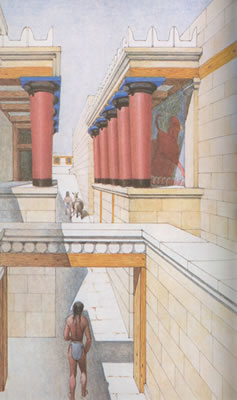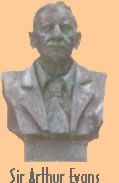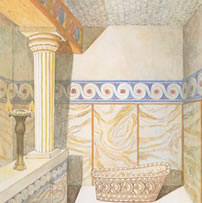 In 1878,
Minos Kalokairinos, a Cretan merchant and antiquarian, carried out the first excavations on the site of Knossos, exposing part of the magazines in the west wing
of the palace and a section of the west facade. After Kalokairinos, several others attempted were made to continue the excavations: W. J. Stillman, the American Consul in Greece,
H. Schliemann, the excavator of Mycenae and Troy, together with his collaborator W. Doerpfeld, M. Joubin, a French archaeologist and Sir Arthur Evans, director
of the British Ashmolean Museum in Oxford and a wealthy amateur archaeologist.
In 1878,
Minos Kalokairinos, a Cretan merchant and antiquarian, carried out the first excavations on the site of Knossos, exposing part of the magazines in the west wing
of the palace and a section of the west facade. After Kalokairinos, several others attempted were made to continue the excavations: W. J. Stillman, the American Consul in Greece,
H. Schliemann, the excavator of Mycenae and Troy, together with his collaborator W. Doerpfeld, M. Joubin, a French archaeologist and Sir Arthur Evans, director
of the British Ashmolean Museum in Oxford and a wealthy amateur archaeologist.
Whether their abandoned efforts were due to lack of success in purchasing the land or denial by Ottoman authorities of such a purchase is unclear, but it was't until March of 1900 that Evans began. Though the basic excavation took four years, he continued working on the site for the rest of his life, doing both building and reconstruction, with great concern for preservation of the remains after their exposure to weather for the first time after three and a half millennia.
He called the main building at Knossos a palace and the civilization that had built it the Minoan civilization, naming it after King Minos of Greek myth. Since his time other theories have been advanced as to the actual function of this and other so-called Minoan palaces. Some say that they were administrative centers or temples (or both). Knossos has been considered, according to another interpretation, a necropolis-a huge burial site to which only priests and embalmers were allowed access.
 Evans, whose father was also an amateur archaeologist, had an excellent team working with him, comprised of both British and Greek (including
Cretan) archaeologists. It has been suggested that Evans, coming from the British Victorian society of his time, projected the image of British monarchical society onto the
Minoan's. (The Queens bath drawing below right)
Evans, whose father was also an amateur archaeologist, had an excellent team working with him, comprised of both British and Greek (including
Cretan) archaeologists. It has been suggested that Evans, coming from the British Victorian society of his time, projected the image of British monarchical society onto the
Minoan's. (The Queens bath drawing below right)
 He defined the
main building as a palace and named various chambers for the Minoan Kings and Queens. His rebuilding of large parts of the sites, though often criticized, was clearly necessary
, as in the case of the Great Stairway which could have collapsed on the workers had it not been restored. Evans spent his personal fortune on the excavations of Knossos and the
rest of his life studying Minoan civilization.
He defined the
main building as a palace and named various chambers for the Minoan Kings and Queens. His rebuilding of large parts of the sites, though often criticized, was clearly necessary
, as in the case of the Great Stairway which could have collapsed on the workers had it not been restored. Evans spent his personal fortune on the excavations of Knossos and the
rest of his life studying Minoan civilization.
Those who followed him, including those who differed with his conclusions, were working upon the foundation he laid, both figuratively and literally. The capital town of Knossos was built by the ancient Phoenicians, who also colonized the island of Crete, an island with land good for the vine and the olive tree which were major staples of the ancient Mediterranean and Aegean.